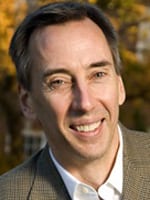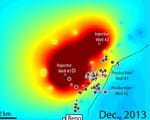A bold, scientist-backed effort to achieve the impossible within the next five years may benefit all runners—even if the goal remains a moonshot.
The work of SMU physiologist and biomechanics researcher Peter G. Weyand was featured in an article in Outside Magazine about an international scientific collaboration’s effort to crack the sub-two hour marathon.
Weyand leads the SMU Locomotor Performance Laboratory and is recognized worldwide as an expert in human running performance. An expert in the locomotion of humans and other terrestrial animals, Weyand’s broad research interests focus on the relationships between muscle function, metabolic energy expenditure, whole body mechanics and performance.
An associate professor of applied physiology and biomechanics in SMU’s Annette Caldwell Simmons School of Education and Human Development, Weyand is one of the world’s leading scholars on the scientific basis of human performance. His research on the importance of ground forces for running speed established a contemporary understanding that spans the scientific and athletic communities.
In particular, his finding that speed athletes are not able to reposition their legs more rapidly than non-athletes debunked a widespread, but baseless belief. Rather, Weyand and colleagues demonstrated sprinting performance is largely set by the force with which one presses against the ground and how long one applies that force.
This work provided the understanding that enabled Weyand and colleagues to investigate the influence of prosthetic limbs on sprint running performance.
Weyand’s research on the limits of human and animal performance has led to featured appearances on the British Broadcasting Corporation, the Canadian Broadcasting Corporation, CNN, the Discovery Channel, the History Channel, NHK Television Japan, National Public Radio and others.
The article published April 10, 2015.
EXCERPT:
By Brian Alexander
Outside Magazine
Last year, when University of Brighton professor Yannis Pitsiladis announced Sub2-Hrs, an organized effort to break the two-hour marathon barrier within five years—a milestone akin to the four-minute mile or the ten-second 100 meters—a chorus of naysayers sprang to their feet in protest. Exercise physiologist Ross Tucker even called the effort “disingenuous” on his sports science blog.Any number of theories have been floated as to why the Sub2-Hrs effort will fail, but all of them may be missing the point. The object of the exercise, according to team member Peter Weyand, a professor of applied physiology at Southern Methodist University, is to assemble a team of experts in various segments of human performance including genetics, physiology, training, nutrition, medicine, biomechanics and see what happens.
The exact details of the Sub2-Hrs project aren’t yet available. It’s unknown at this point, for example, if there will be some compound where athletes will train and live together under the supervision of clipboard-carrying scientists. Weyand said the plan is to screen runners who have dominated distance running (likely East Africans), for genetic variants that might predispose them to success, then apply the skills of other experts toward improving those elite athletes’ running efficiency, diet, avoiding injuries, and so on, so that one of them may break that two hour barrier within the next five years.
“There are a number of basic questions about why people run the way they do,” Weyand explained. “What movement patterns are best for performance? Are they the same patterns that prevent injuries? There is a sea of unanswered questions.”
Follow SMUResearch.com on twitter at @smuresearch.
SMU is a nationally ranked private university in Dallas founded 100 years ago. Today, SMU enrolls nearly 11,000 students who benefit from the academic opportunities and international reach of seven degree-granting schools. For more information see www.smu.edu.
SMU has an uplink facility located on campus for live TV, radio, or online interviews. To speak with an SMU expert or book an SMU guest in the studio, call SMU News & Communications at 214-768-7650.


 Most likely cause of 2013-14 earthquakes: Combination of gas field fluid injection, removal
Most likely cause of 2013-14 earthquakes: Combination of gas field fluid injection, removal Physicists tune Large Hadron Collider to find “sweet spot” in high-energy proton smasher
Physicists tune Large Hadron Collider to find “sweet spot” in high-energy proton smasher 17 million-year-old whale fossil provides 1st exact date for East Africa’s puzzling uplift
17 million-year-old whale fossil provides 1st exact date for East Africa’s puzzling uplift SMU analysis of recent North Texas earthquake sequence reveals geologic fault, epicenters in Irving and West Dallas
SMU analysis of recent North Texas earthquake sequence reveals geologic fault, epicenters in Irving and West Dallas Bitcoin scams steal at least $11 million in virtual deposits from unsuspecting customers
Bitcoin scams steal at least $11 million in virtual deposits from unsuspecting customers Teen girls report less sexual victimization after virtual reality assertiveness training
Teen girls report less sexual victimization after virtual reality assertiveness training